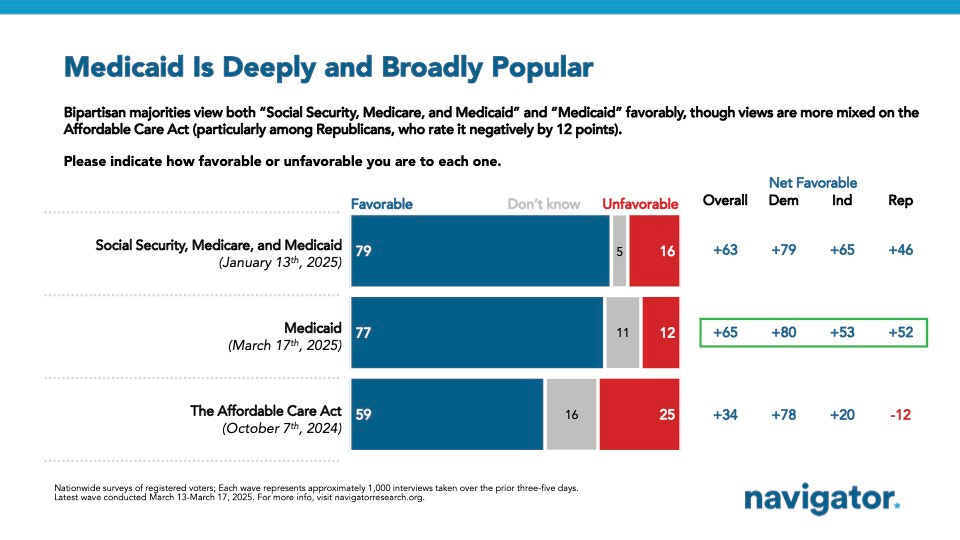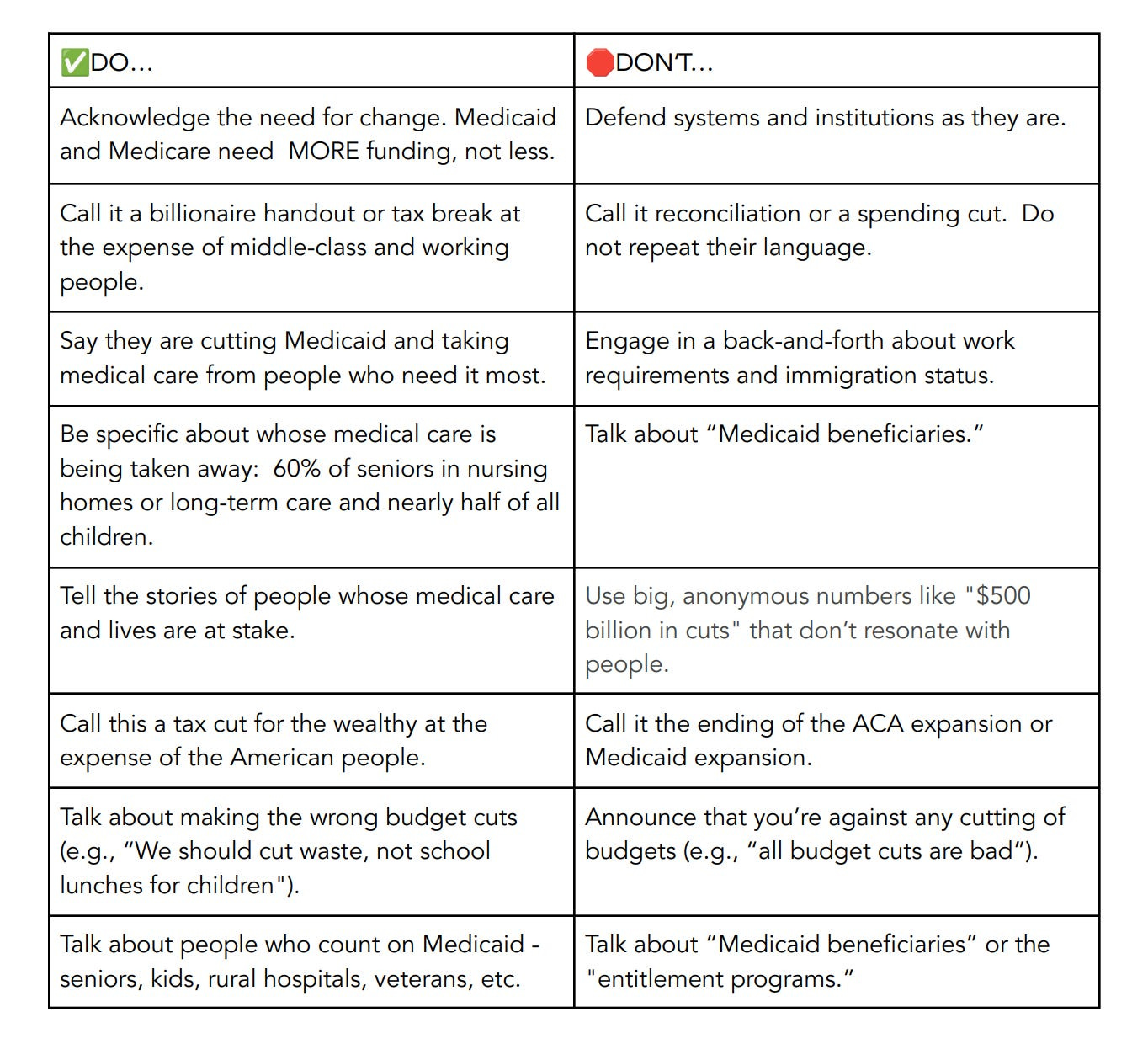Trump Wants to Cut Medicaid; Here's How Dems Can Stop Him
Dems can make Republicans feel real heat for cutting Medicaid to pay for tax cuts for the ultra-wealthy
Donald Trump is facing two significant economic challenges.
The first is the impact of his unpredictable and often chaotic tariff policies, which have introduced substantial uncertainty into the economy. Prices are rising, economic growth is slowing, and companies are pulling back on hiring and investment because of the massive amount of uncertainty that comes with a president with the attention span of a toddler after a case of Fun Dip.
The second problem is also one of his own making. The tax cuts he passed in 2017 are set to expire at the end of the year. If the Republican Congress does nothing—which has been their usual approach—taxes will go up on nearly every American. While it’s fair to expect the ultra-wealthy, Wall Street Banks, hedge funds, and large corporations to pay more, raising taxes on the middle and working class at a time of rising prices would be economically devastating.
The current Republican plan to extend these tax cuts comes with a hefty price tag, demanding massive cuts to Medicaid to help cover the cost. Unsurprisingly, the benefits of these tax cuts would overwhelmingly go to large corporations and the ultra-wealthy.
In other words, to give more money to the people who need it least, Trump and the Republicans are proposing to slash healthcare for the poorest Americans. It’s not just cruel and morally bankrupt—it’s also politically reckless. Cutting Medicaid to pay for tax breaks for the rich sounds like something cooked up in a lab specifically to cost Republicans the majority.
Because Republicans are using the budget reconciliation process, they only need a simple majority in the House and the Senate to pass this bill, effectively locking Democrats out of the legislative fight. But, as we saw during Trump’s failed attempt to repeal the Affordable Care Act in 2017, there’s still a path to victory. By making these Medicaid cuts so politically toxic and painful that Republicans are forced to back down, Democrats—and all of us—can still win this fight.
What is Medicaid?
Most Americans are familiar with Medicare and Social Security, but Medicaid is a broader, more complex program, making it harder to define. This complexity is one reason Republicans are more willing to target Medicaid for cuts, while shying away from more politically untouchable programs like Social Security and Medicare.
Here are some key facts about Medicaid:
Coverage Reach: About 1 in 4 Americans are enrolled in Medicaid.
Births: Roughly half of all births in the U.S. are covered by Medicaid.
Long-Term Care: Medicaid covers 63% of nursing home residents, providing essential support to seniors who can no longer live independently.
Children and Disability: While about 40% of enrollees are children, most Medicaid spending goes to care for the elderly and people with disabilities.
Medicaid Is Incredibly Popular
For decades, the core, enduring truth of the Republican Party has been a commitment to cutting, eliminating, or privatizing programs like Social Security, Medicare, and Medicaid—anything that provides Americans with financial security through life’s ups and downs. Over time, however, Republicans have come to understand that openly targeting Social Security and Medicare is politically dangerous. They've largely moved away from the aggressive cuts once championed by figures like George W. Bush, Mitt Romney, and Paul Ryan, though the desire to undermine these programs remains. In fact, during his first term, Trump proposed cuts to Social Security and Medicare in every budget he submitted.
So why focus on Medicaid now? Republicans believe it’s a softer target. They think the politics are more favorable, assuming that Medicaid lacks the same deep, emotional attachment among voters as Social Security and Medicare. However, as polling from Navigator Research shows, while Social Security and Medicare may enjoy slightly higher favorability, Medicaid is not far behind in popularity.
Remember the immense backlash to Trump’s efforts to repeal the Affordable Care Act? Medicaid is 18 points more popular than the ACA.
A Kaiser Family Foundation poll found that 65% of Trump voters want to increase or keep Medicaid funding the same, while only 19% want to decrease it significantly.
Trump voters' support for Medicaid makes sense given that Trump won working-class voters in 2024.
Cuts to Medicaid will be a significant issue in the 2026 midterms. Politico reported on a poll of battleground House districts that found:
When given a brief description of Medicaid, two-thirds of voters in battleground Congressional Districts (68%) say cutting Medicaid benefits in order to pay for tax cuts is a bad idea, while only 22% say it is a good idea. Republicans (42% good idea – 44% bad idea), Independents (23% – 61%), and Democrats (2% – 94%) are all more likely to say cutting Medicaid is a bad idea, as are voters across all gender, age, ethnicity, and education levels. Those voters who are already highly interested in the 2026 Congressional election are even more likely to say cutting Medicaid is a bad idea (21% good idea – 70% bad idea).
When you look at these numbers, it seems truly insane that Republicans are going to gut Medicaid to pay for a tax cut that primarily benefits the ultra-wealthy. They hope to pass the cuts before the public notices and then change the subject to something more favorable before people start voting next year.
It’s our job to make sure that doesn’t happen.
How To Stop the Medicaid Cuts
The latest version of the House Budget bill does not include some of the most drastic cuts considered earlier in the process. But just because something could be worse doesn’t mean that it’s good. The Congressional Budget Office estimates that the Republican plan would cut Medicaid by $715 billion over a decade and result in 13.7 million more Americans being uninsured.
Because they cannot get their shit together, it’s genuinely impossible to know what will be in the final bill, but it is safe to assume that anything Republicans do will mean working people losing access to health care.
Democrats need to pick a big, noisy fight. We need to show our base that we have the strength and the courage to take on Trump and the MAGA Republicans. A growing segment of voters is concerned that Trump is going too far, that he is overreaching, and that they are looking for someone who can check his power. But too many Americans, including many Democrats, aren’t sure we have what it takes to be a faithful bulwark against Trump, his self-dealing, and emerging fascism.
The primary legislative battle of this year is the effort to pass Trump’s tax cuts and pay for them with Medicaid cuts. This will likely be the only significant piece of legislation that this narrowly divided, deeply dysfunctional Congress will take up. If we want a big fight, this is the one to pick.
The Republicans may commit ritual political suicide because Trump tells them to. If they do, it’s also possible that Democrats can force them to back off, protecting health care for millions of Americans. To win, we need to make the 18 Republicans in districts rated toss-up or “lean Republican” by the Cook Political Report realize that cutting Medicaid will cost them their race.
To do so, we must make our voices heard in the following ways:
Call Congress: I know it sounds trite, but calling your member of Congress is the best way to make your voice heard. In most offices, the members and the senior staff get a weekly report on the call/email traffic. If the offices are flooded with calls angry at a policy of kicking pregnant women, children, and the elderly off their health care to pay for a tax cut for the ultra-wealthy, it will not go unnoticed. Most members of Congress do not run regular polls of their districts, so the calls are their only window into public opinion.
Show Up at Protests and Town Halls: Mass mobilization is a powerful way to make Republican members of Congress realize that voting for Medicaid cuts will cost them their jobs. The atmosphere around this bill needs to feel as intense and unrelenting as the fight to save Obamacare. Republicans need to see and hear that people are fired up—that these cuts have ignited the Democratic base and are pushing swing voters away.
This can take many forms, from joining protests like the Hands Off events or the 50501 rallies, to showing up at town halls organized by Republican members (if any are brave enough to hold them). It also means supporting town halls in Republican districts organized by Democrats like Ro Khanna, Chris Murphy, Maxwell Frost, Tim Walz, and others, who are stepping up to fill the gap and give people a voice.
Talk to Your Friends and Family: The central conceit of this newsletter is that YOU are the Democratic Party’s best messenger. The people in your life trust you more than any politician or member of the media. Most people don’t follow the news closely enough to know that Republicans want to cut Medicaid to pay for tax cuts that overwhelmingly benefit the ultra-wealthy and corporations. And they won’t know, unless you tell them. My friends at Navigator Research put together a very handy guide on how to talk about the cuts:
It’s easy to give in to the cynicism and believe that Trump is too strong and Democrats are too weak, but this is a fight we can win. We can stop the Medicaid cuts, and if Republicans vote for them anyway, we can make sure they pay the price next fall.





I’ve made so many calls & sent a bunch of emails (and postcards) about cuts to Medicaid. I’m going to keep doing it.
Brilliant, as always, but I have the teensiest note: when you make a "Do-Don't" chart, it's helpful to put the last thing you read as the one you want us to remember. As I read the chart, I realized I was thinking about the "Don't" language because it was on the right.
But thanks as always for the good advice!